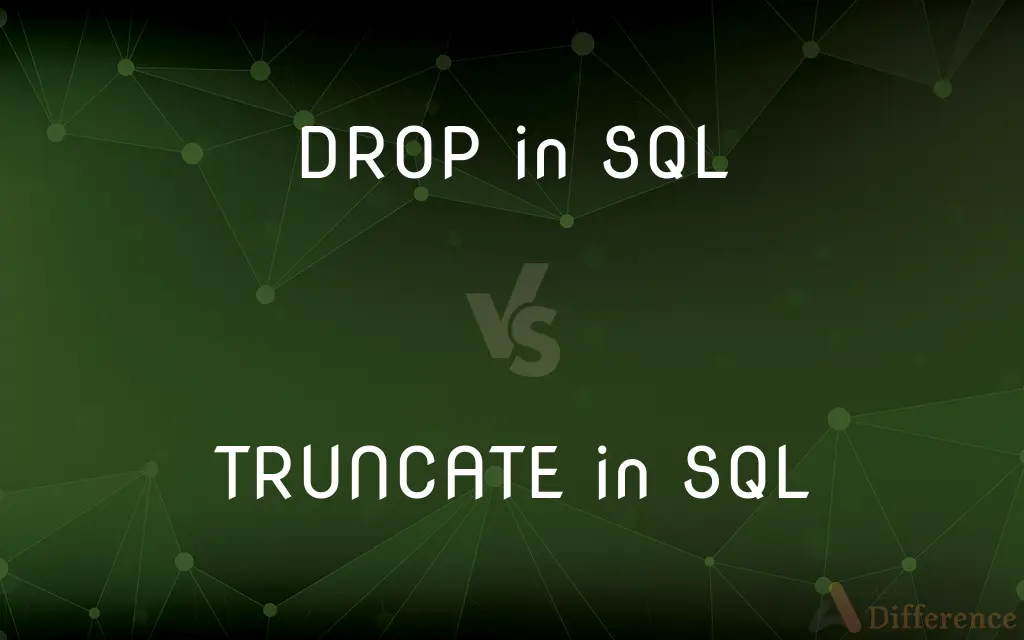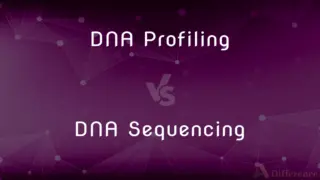DROP in SQL vs. TRUNCATE in SQL — What's the Difference?
By Tayyaba Rehman — Published on January 14, 2024
DROP in SQL completely removes a database, table, or index; TRUNCATE in SQL quickly removes all rows from a table, but not the table itself.

Difference Between DROP in SQL and TRUNCATE in SQL
Table of Contents
ADVERTISEMENT
Key Differences
The DROP command in SQL is used to permanently remove an object, such as a table or a database, from the database system. Once a table or database is dropped, it cannot be recovered unless a backup is available. On the other hand, the TRUNCATE command is used to delete all records from a table but keeps the table structure for future use. This means that the table still exists, but it is empty after a TRUNCATE operation.
DROP in SQL is a Data Definition Language (DDL) command. It not only removes the data within the table or database but also the structure of the table or the entire database schema. Conversely, TRUNCATE is also a DDL command but it deals only with deleting the data within a table without affecting its schema or structure.
When executing the DROP command, the database engine removes the table and its associated data, indexes, constraints, triggers, and permissions. It is a more drastic operation compared to TRUNCATE. TRUNCATE, on the other hand, quickly removes all data from a table but does not log the deletion of each row, making it a faster operation, especially for large tables.
After using DROP, recovering data can be challenging and relies on having backups. In contrast, since TRUNCATE doesn't remove the table itself, it's often used in situations where the table structure needs to be preserved for future data storage. TRUNCATE also resets any auto-increment counters to their initial value.
In summary, DROP and TRUNCATE are SQL commands used for different purposes. DROP is used for removing tables, databases, or other database objects entirely, while TRUNCATE is specifically for efficiently clearing all data from a table while maintaining its existence and structure.
ADVERTISEMENT
Comparison Chart
Operation Type
Data Definition Language (DDL)
Data Definition Language (DDL)
Effect on Table/Data
Removes table and its schema completely
Deletes all data, but keeps table structure
Recovery
Not recoverable without backup
Data not recoverable, structure remains
Speed
Slower for large tables
Faster, as it doesn’t log individual deletions
Impact on Indexes/Constraints
Removes associated indexes and constraints
Preserves table structure, including indexes and constraints
Usage Scenario
Used to completely remove a table or database
Used to empty a table for future use
Compare with Definitions
DROP in SQL
DROP in SQL also removes table constraints and indexes.
DROP DATABASE Sales; will delete the 'Sales' database and all its associated elements.
TRUNCATE in SQL
TRUNCATE resets auto-increment counters.
TRUNCATE TABLE Users; resets the auto-increment primary key of the 'Users' table.
DROP in SQL
DROP in SQL is used for database object deletion.
DROP VIEW CustomerView; will delete the view named 'CustomerView'.
TRUNCATE in SQL
TRUNCATE in SQL is faster than DELETE for emptying a table.
Use TRUNCATE TABLE LogData; to efficiently clear large logging tables.
DROP in SQL
DROP in SQL is irreversible without a backup.
Be cautious when using DROP TABLE, as it permanently deletes the table.
TRUNCATE in SQL
TRUNCATE in SQL deletes all records from a table.
TRUNCATE TABLE Orders; quickly deletes all data from the 'Orders' table.
DROP in SQL
DROP in SQL completely removes a database or table.
DROP TABLE Employees; removes the entire 'Employees' table from the database.
TRUNCATE in SQL
TRUNCATE in SQL keeps the table's structure.
After running TRUNCATE TABLE Inventory;, the 'Inventory' table remains but is empty.
DROP in SQL
DROP is a DDL command in SQL.
To remove an unused index, use the command DROP INDEX IndexName;.
TRUNCATE in SQL
TRUNCATE in SQL does not log individual row deletions.
For quick data removal without logging, TRUNCATE TABLE TemporaryData; is used.
Common Curiosities
What does DROP do in SQL?
DROP in SQL permanently removes a table, database, or other database objects.
Is DROP in SQL reversible?
No, DROP operations are not reversible unless a backup is available.
Can TRUNCATE be used on a view in SQL?
No, TRUNCATE can only be used on tables, not on views.
What is the purpose of TRUNCATE in SQL?
TRUNCATE in SQL is used to delete all records from a table quickly while preserving its structure.
Does DROP in SQL affect table relationships?
Yes, DROP in SQL removes the table and all related constraints and relationships.
Does TRUNCATE in SQL maintain table indexes?
Yes, TRUNCATE maintains the table's structure, including its indexes and constraints.
Can you use DROP on a column in SQL?
Yes, you can use DROP to remove a column from a table with the ALTER TABLE statement.
Is TRUNCATE faster than DELETE in SQL?
Yes, TRUNCATE is generally faster than DELETE as it doesn’t log individual row deletions.
Can DROP be rolled back in SQL?
No, DROP operations cannot be rolled back in standard SQL.
Does TRUNCATE reset AUTO_INCREMENT in SQL?
Yes, TRUNCATE resets the AUTO_INCREMENT counter of a table.
Does TRUNCATE in SQL free up space?
Yes, TRUNCATE frees up space occupied by the data but not by the table itself.
What is the main difference between DROP and TRUNCATE?
DROP completely removes the table and its structure, while TRUNCATE only removes the data but keeps the table structure.
Is DROP in SQL a DML command?
No, DROP is a Data Definition Language (DDL) command.
Is TRUNCATE an atomic operation in SQL?
Yes, TRUNCATE is an atomic operation and cannot be partially performed.
Can I use WHERE clause with TRUNCATE in SQL?
No, TRUNCATE does not support the WHERE clause; it deletes all rows unconditionally.
Share Your Discovery

Previous Comparison
DNA Profiling vs. DNA Sequencing
Next Comparison
Relevant Cost vs. Irrelevant CostAuthor Spotlight
Written by
Tayyaba RehmanTayyaba Rehman is a distinguished writer, currently serving as a primary contributor to askdifference.com. As a researcher in semantics and etymology, Tayyaba's passion for the complexity of languages and their distinctions has found a perfect home on the platform. Tayyaba delves into the intricacies of language, distinguishing between commonly confused words and phrases, thereby providing clarity for readers worldwide.














































